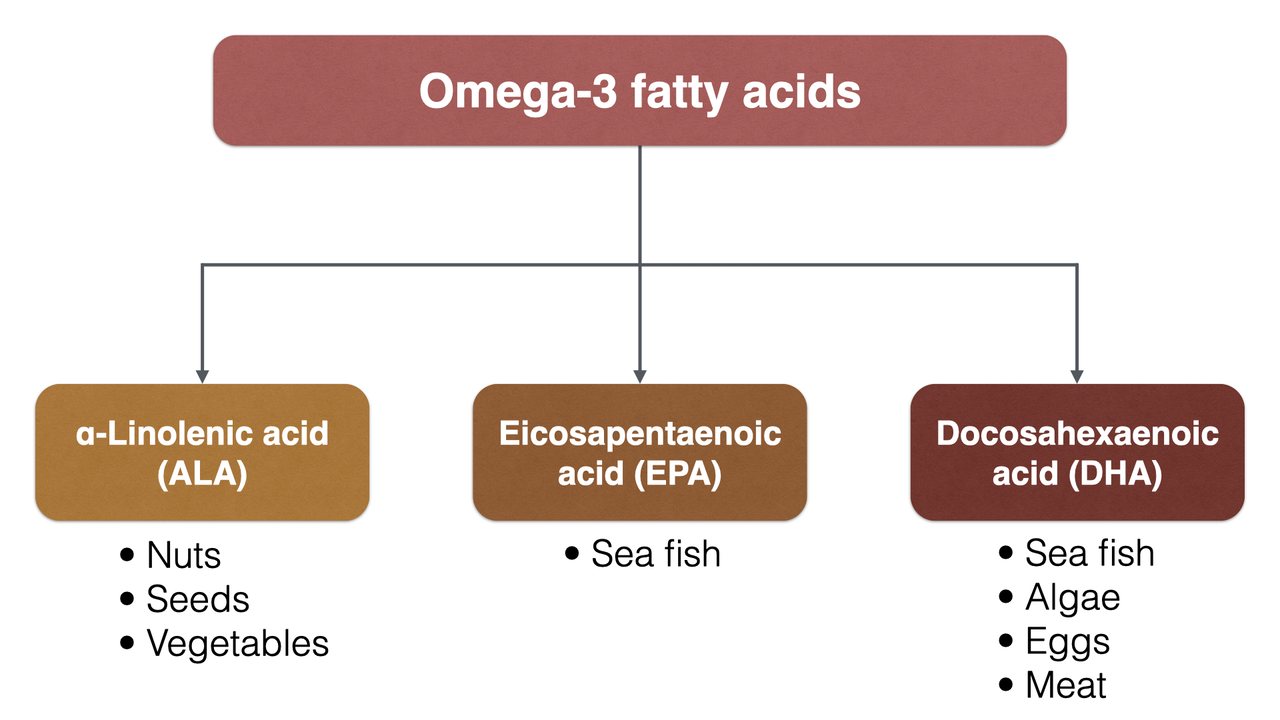How can vegetarians improve their omega-3 fatty acid status?
05/04/2019 Natural food guide OxiPur
The omega-3 fatty acids eicosapentaenoic acid (EPA) and docosahexaenoic acid (DHA) almost exclusively occur in fish. This raises the question: How can vegetarians meet their needs for these essential fats? This matter is also relevant in the context of maritime overfishing, which is an environmental threat on a global scale. Farmed fish, which are raised in questionable conditions and with the massive use of pesticides and antibiotics, are not always a better alternative. Is it possible to meet one's dietary needs with plant based fatty acids?

In order to help you get a better understanding of how much omega-3 (in the form of EPA and DHA) is consumed each day in different regions of the world, let's have a look at table 1:
▲ Table 1: Average omega-3 intake of various populations.
Countries with a high fish consumption naturally have the highest intakes of EPA and DHA. However, many regions fall below the recommendations of public health authorities. The mean values also disguise the fact that fish is not on the menu for a large proportion of the population. To give an example: 27 % of all British never eat fatty sea fish. People who don't eat fish are at the highest risk of a critical undersupply. But meat eaters, too, may have an insufficient intake. In the US, only 10 % of the population are considered to meet the daily needs for omega-3 fatty acids.
First the good news: All kinds of vegetarians, no matter if vegan, ovo-lacto or pescetarians (vegetarians who include fish in their diet), have a significantly lower risk of cardiovascular disease. However, to date it is unclear whether that risk can be lowered even more with an adequate supplementation of EPA and DHA.
Omega-3 fatty acids are an integral part of the cell membranes throughout the body. Studies have revealed that in vegetarians the proportion of EPA and DHA in these membranes are only half of those of meat eaters. This is certainly not a big surprise, as vegetarians do not eat seafood, but it raises concerns about whether vegetarians may have a suboptimal omega-3 status.
One approach for a better supply with omega-3 is to up the intake of the less potent α-linolenic acid (ALA). As a vegetarian your diet is usually rich in nuts, seeds and vegetables which are rich sources of ALA (see figure 1). Humans are able to convert ALA to the more physiologically active fatty acids EPA and DHA, although there is contradictory evidence about the exact conversion rates.
 ▲ Figure 1: The most important omega-3 fatty acids and their main sources in our diet.
▲ Figure 1: The most important omega-3 fatty acids and their main sources in our diet.
Studies showed that a higher intake of ALA will actually cause a rise of EPA levels in the blood, although conversion rates are low. In women the conversion rates typically range from 5 to 10 %, but with rates below 5 % they are lower in men. The rate of conversion depends on the intake of omega-6 fats, only a balanced ratio of omega-6 to omega-3 in the range of 5:1 or lower guarantuees an optimal conversion rate. It is still very difficult to meet the needs for DHA this way.
There are alternatives, such as microalgae, that naturally produce EPA and DHA. The extracted algae oil is a good source of omega-3 fatty acids and can be used to supplement DHA. Studies showed that within a few months of supplementation with algae oil the proportion of DHA in the cell membranes rises. However, the producers of such oils charge a high price for their capsules, approximately tenfold of what a comparable amount of fish oil would cost. Another alternative could be bioengineered yeasts, programmed to produce EPA and DHA, which would be a cheap way to obtain those fatty acids. This branch is still in its infancy, but it is estimated that the demand for vegetarian sources is on the rise and the industry will adapt to it. In the meantime, you must not let yourself be scared by the marketing propaganda of the omega-3 industry.
Despite the inefficient conversion of ALA, there is reason to believe that the conversion levels are sufficient when the ALA input is high enough and in balance with the intake of omega-6 fatty acids. The conversion rates are best when the ratio is 5:1 or smaller.
However, there are situations where your individual requirements are increased, e.g. during pregnancy or if you suffer from chronic disease (e.g. hypertension, diabetes, ...). In these cases you should consider an appropriate substitution. If you follow a vegan lifestyle, you should consider a supplement as you cannot rely on eggs as a source of DHA.
Back to blog
Literature:
D. Givens et al., Current intakes of EPA and DHA in European populations and the potential of animal-derived foods to increase them, Proceedings of the Nutrition Society (2008), 67, 273-280
A. Welch et al., Dietary intake and status of n-3 polyunsaturated fatty acids in a population of fish-eating and non-fish-eating meat-eaters, vegetarians, and vegans and the precursor-product ratio of α-linolenic acid to long-chain n-3 polyunsaturated fatty acids: results from the EPIC-Norfolk cohort, Am J Nutr 2010, 92:1040-51
J. Brenna et al., α-Linolenic acid supplementation and conversion to n-3 long-chain polyunsaturated fatty acids in humans, Prostaglandins, Leukotrienes and Essential Fatty Acids (PLEFA), 2009, Vol.80(2), pp.85-91
W. Harris, Achieving optimal n-3 fatty acid status: the vegetarian's challenge... or not, Am J Clin Nutr. 2014 Jul,100 Suppl 1:449S-52S
B. Davis et al., Achieving optimal essential fatty acid status in vegetarians: current knowledge and practical implications, Am J Clin Nutr 2003,78(suppl):640S-6S
Image:
Photo by Karsten Winegeart on Unsplash

What is the average intake of omega-3 in different regions of the world?
In order to help you get a better understanding of how much omega-3 (in the form of EPA and DHA) is consumed each day in different regions of the world, let's have a look at table 1:
| Land or region | Specification | Intake of EPA + DHA (mg/day) |
|---|---|---|
| General | Low consumption of fish | <<100 |
| Australia | Adults | 143 |
| North America | Adults | 200 |
| UK | Adults | 244 |
| Central Europe | Adults | 250 |
| France | Women, 45–63 years | 344 |
| Northern Europe | Adults | 590 |
| Japan | Adults | 950 |
Countries with a high fish consumption naturally have the highest intakes of EPA and DHA. However, many regions fall below the recommendations of public health authorities. The mean values also disguise the fact that fish is not on the menu for a large proportion of the population. To give an example: 27 % of all British never eat fatty sea fish. People who don't eat fish are at the highest risk of a critical undersupply. But meat eaters, too, may have an insufficient intake. In the US, only 10 % of the population are considered to meet the daily needs for omega-3 fatty acids.
Influence of omega-3 fatty acids on heart disease
First the good news: All kinds of vegetarians, no matter if vegan, ovo-lacto or pescetarians (vegetarians who include fish in their diet), have a significantly lower risk of cardiovascular disease. However, to date it is unclear whether that risk can be lowered even more with an adequate supplementation of EPA and DHA.
Omega-3 fatty acids are an integral part of the cell membranes throughout the body. Studies have revealed that in vegetarians the proportion of EPA and DHA in these membranes are only half of those of meat eaters. This is certainly not a big surprise, as vegetarians do not eat seafood, but it raises concerns about whether vegetarians may have a suboptimal omega-3 status.
The importance of an ideal omega-6 to omega-3 ratio in your diet
One approach for a better supply with omega-3 is to up the intake of the less potent α-linolenic acid (ALA). As a vegetarian your diet is usually rich in nuts, seeds and vegetables which are rich sources of ALA (see figure 1). Humans are able to convert ALA to the more physiologically active fatty acids EPA and DHA, although there is contradictory evidence about the exact conversion rates.

Studies showed that a higher intake of ALA will actually cause a rise of EPA levels in the blood, although conversion rates are low. In women the conversion rates typically range from 5 to 10 %, but with rates below 5 % they are lower in men. The rate of conversion depends on the intake of omega-6 fats, only a balanced ratio of omega-6 to omega-3 in the range of 5:1 or lower guarantuees an optimal conversion rate. It is still very difficult to meet the needs for DHA this way.
What about vegan omega-3 supplements?
There are alternatives, such as microalgae, that naturally produce EPA and DHA. The extracted algae oil is a good source of omega-3 fatty acids and can be used to supplement DHA. Studies showed that within a few months of supplementation with algae oil the proportion of DHA in the cell membranes rises. However, the producers of such oils charge a high price for their capsules, approximately tenfold of what a comparable amount of fish oil would cost. Another alternative could be bioengineered yeasts, programmed to produce EPA and DHA, which would be a cheap way to obtain those fatty acids. This branch is still in its infancy, but it is estimated that the demand for vegetarian sources is on the rise and the industry will adapt to it. In the meantime, you must not let yourself be scared by the marketing propaganda of the omega-3 industry.
Who needs EPA and DHA as a nutritional supplement anyway?
Despite the inefficient conversion of ALA, there is reason to believe that the conversion levels are sufficient when the ALA input is high enough and in balance with the intake of omega-6 fatty acids. The conversion rates are best when the ratio is 5:1 or smaller.
However, there are situations where your individual requirements are increased, e.g. during pregnancy or if you suffer from chronic disease (e.g. hypertension, diabetes, ...). In these cases you should consider an appropriate substitution. If you follow a vegan lifestyle, you should consider a supplement as you cannot rely on eggs as a source of DHA.
Do you want to learn more about the importance of omega-3 in your food?
 Our app "Natural Food Guide" contains detailed information about the content of EPA, DHA and ALA and the omega-6 to omega-3 ratio. Check it out on the App Store!
Our app "Natural Food Guide" contains detailed information about the content of EPA, DHA and ALA and the omega-6 to omega-3 ratio. Check it out on the App Store!
Share article
Share article
Back to blog
Literature:
D. Givens et al., Current intakes of EPA and DHA in European populations and the potential of animal-derived foods to increase them, Proceedings of the Nutrition Society (2008), 67, 273-280
A. Welch et al., Dietary intake and status of n-3 polyunsaturated fatty acids in a population of fish-eating and non-fish-eating meat-eaters, vegetarians, and vegans and the precursor-product ratio of α-linolenic acid to long-chain n-3 polyunsaturated fatty acids: results from the EPIC-Norfolk cohort, Am J Nutr 2010, 92:1040-51
J. Brenna et al., α-Linolenic acid supplementation and conversion to n-3 long-chain polyunsaturated fatty acids in humans, Prostaglandins, Leukotrienes and Essential Fatty Acids (PLEFA), 2009, Vol.80(2), pp.85-91
W. Harris, Achieving optimal n-3 fatty acid status: the vegetarian's challenge... or not, Am J Clin Nutr. 2014 Jul,100 Suppl 1:449S-52S
B. Davis et al., Achieving optimal essential fatty acid status in vegetarians: current knowledge and practical implications, Am J Clin Nutr 2003,78(suppl):640S-6S
Image:
Photo by Karsten Winegeart on Unsplash
![[Blog]](../../rw_common/images/baliza_logo_retina.png)
